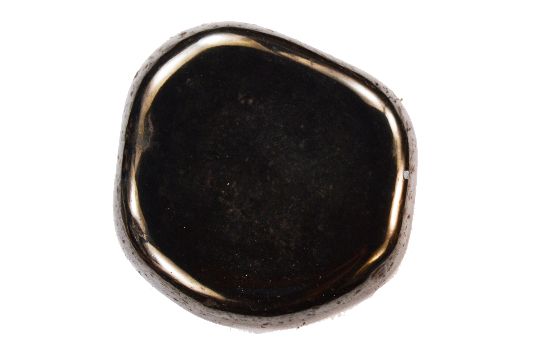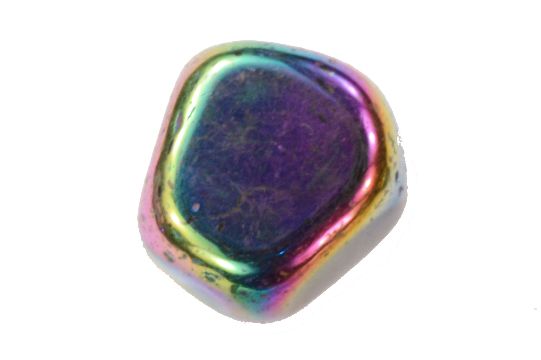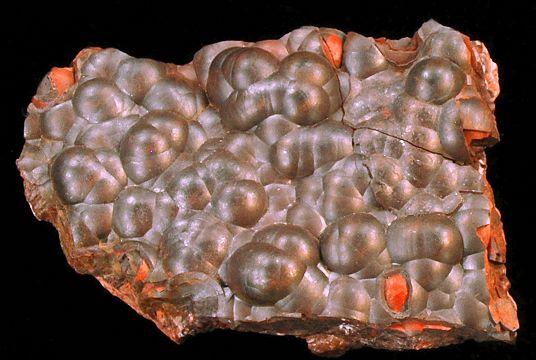Hematite – Mineral and Healing Properties
Chemistry: Fe2O3, Iron Oxide
Class: Oxides and Hydroxides
Uses: Very important ore of iron, as a pigment and as mineral specimens.



Hematite is one of the most abundant minerals on Earth’s surface and in the shallow crust. It is an iron oxide with a chemical composition of Fe2O3. It is a common rock-forming mineral found in sedimentary, metamorphic, and igneous rocks at locations throughout the world.
Hematite has an extremely variable appearance. Its luster can range from earthy to submetallic to metallic. Its color ranges include red to brown and black to gray to silver. It occurs in many forms that include micaceous, massive, crystalline, botryoidal, fibrous, oolitic, and others.
Even though hematite has a highly variable appearance, it always produces a reddish streak. Students in introductory geology courses are usually surprised to see a silver-colored mineral produce a reddish streak. They quickly learn that the reddish streak is the most important clue for identifying hematite.
Hematite is not magnetic and should not respond to a common magnet. However, many specimens of hematite contain enough magnetite that they are attracted to a common magnet.
Kidney Ore Hematite, also known as Botryoidal Hematite, precipitates in cavities and has the opportunity to form an unrestricted habit. A habit known as “kidney ore” often develops in cavities and is named for its similar visual appearance to an internal organ. This type of chemically precipitated hematite is often relatively uncontaminated with sedimentary clay or host rock inclusions and has a higher purity.
Origin Of The Name
The name hematite is derived from the Greek word for blood haima because hematite can be red, as in rouge, a powdered form of hematite. The color of hematite lends itself to use as a pigment. The English name of the stone is derived from Middle French: Hématite Pierre, which was imported from Latin: Lapis Hæmatites around the 15th century, which originated from Ancient Greek: (haimatit’s lithos, meaning blood-red stone).
Interesting Facts
The red chalk writing of this mineral was one of the earliest writing in the history of humans. The powdery mineral was first used 164,000 years ago by the Pinnacle-Point man possibly for social purposes. Hematite residues are also found in graves from 80,000 years ago. Near Rydno in Poland and Lovas in Hungary red chalk mines have been found that are from 5000 BC, belonging to the Linear Pottery culture at the Upper Rhine.
The spectral signature of hematite was seen on the planet Mars by the infrared spectrometer on the NASA Mars Global Surveyor (“MGS”) and 2001 Mars Odyssey spacecraft in orbit around Mars.
Hematite’s popularity in jewelry was at its highest in Europe during the Victorian era.
Where Is It Found
Hematite has numerous good localities, and therefore only the finest will be mentioned. Large and thick crystals have been found in Minas Gerais, Brazil, particularly at Antonio Pereira, Congonhas de Campo, Jaguaracu, and Itabira. Lustrous plates with flat or tabular crystals come from Novo Horizonte and Brumado, Bahia, Brazil. Most of the tumbled, polished Hematite comes from Minas Gerais.
Cumberland, in Cumbria, England, is a major source of Hematite specimens, especially the Specularite variety, as well as much of the globular and stalactitic specimens. Another classic occurrence is Rio Marina, on the island of Elba, Italy. The Cavradi Gorge in Tujetsch, Grischun, Switzerland is well-known for its outstanding and unique lustrous tabular Hematite crystals.
Morocco has also been a recent producer of fine collectible Hematite, with special note on Nador in the Nador Province, where excellent crystals and clusters have been found. The Wessels Mine in Hotazel, in the Kalahari manganese fields of South Africa has produced outstanding lustrous crystals including the rare prismatic forms.
In the U.S., enormous Hematite deposits exists throughout the western area of Lake Superior, especially in the Menominee iron range, Iron Co., Michigan. “Iron Roses” occur in the Thomas Range in Utah, as well as in numerous localities in Arizona, namely Aztec Peak, Gila Co.; Bouse, Yuma Co.; and in the Buckskin Mountains in La Paz Co. A classic New York locality is Chub Lake, St. Lawrence Co.
What Do We Do With It
Hematite is the principle ore of iron. Huge quantities are mined throughout the world for industrial production. It is the source for roughly 90 percent of all iron mined in the United States. Hematite was largely used in the past as a red and brown pigment, although nowadays cheaper sources have been substituted. Well formed Hematite crystals are popular among mineral collectors, and tumbled, highly lustrous Hematite from Brazil makes a very popular, inexpensive specimen for amateur collectors.
Hematite is also used as a minor gemstone. It is cut and polished into cabochons for jewelry and ornaments, fashioned into beads for bracelets and necklaces, and carved into ornamental figures.
Metaphysical Uses
Hematite helps to absorb negative energy and calms you in times of stress or worry. Hematite is a very protective stone, and is great to carry to help you stay grounded in many situations. Hematite can boost confidence, and is also good for working with the Root Chakra.
Hematite can help one to find their own gifts and to release self-imposed limitations. It can help with the ascension process by facilitating the integration of higher spiritual energies into our physical 3-D existence.
Hematite is also used to protect against geopathic stress and electromagnetic smog, and is said to be a great detoxifying stone, helpful for the liver and the blood.
Considered the symbol of life energy, hematite allows for more confidence, will power and boldness. Helps us adjust to being physical. A protective stone and helps bolster low self-esteem. Hematite is known to deflect negativity. It restores equilibrium, stability and is also used for astral protection. It brings our awareness back to the body and helps one maintain their sense of self. If worn, Hematite should be placed near the base of the spine.
Physical Characteristics
Color: Steel or silver gray to black in some forms and red to brown in earthy forms.
Luster: Metallic or dull.
Transparency: Crystal are opaque.
Crystal System: Trigonal; bar 3 2/m
Crystal Habits: Tabular crystals of varying thickness sometimes twinned, micaceous (specular), botryoidal and massive. also earthy or oolitic.
Cleavage: None
Fracture: Uneven
Hardness: 5 to 6
Specific Gravity: 5.3
Streak: Blood red to brown red.
Associated Minerals: Jasper in banded iron formations (BIF or Tiger Iron), dipyramidal quartz, rutile, and pyrite among others.
Best Field Indicators: Crystal habit, streak and hardness.


